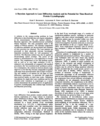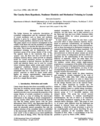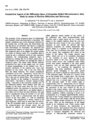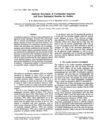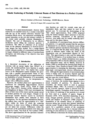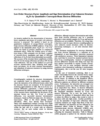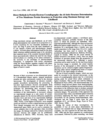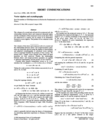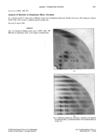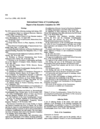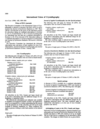issue contents
November 1996 issue

Cover illustration: Indicatrix of the inverse of Young's modulus for ADP, a tetragonal crystal. Courtesy of A. Authier, Laboratoire de Minéralogie-Cristallographie, Université Pierre et Marie Curie, Paris, France.
research papers
A combination rule of Σ values at triple junctions in cubic polycrystals is given and several models of grain-boundary networks composed of specially selected coincidence boundaries are shown.
A statistical method of deconvoluting energetic and spatial overlaps in Laue diffraction patterns is described. A test application demonstrates that the new approach solves the problem of the `low-resolution hole' in protein crystallography and yields density maps of high quality.
Theory and algorithms for calculating fiber diffraction patterns from polycrystalline fibers of helical molecules that contain correlated lattice disorder are presented. Calculated patterns illustrate the effects of correlated disorder, and comparison of calculated and measured diffraction patterns reveals the presence of correlated disorder in a polynucleotide fiber.
Bravais's original criterion for the classification of the three- dimensional lattices gives only 11 distinct lattice types, as opposed to the classical 14 types obtained from the conjugacy classes of arithmetic holohedries in GL(3,Z).
The natural hypothesis by Cauchy and Born that bridges the molecular descriptions of crystalline configurations and the continuum theories for crystal mechanics is mostly not valid for mechanical twinning deformations. This implies that nonlinear elasticity theory can be used to model the behavior of crystalline substances only in very special cases that are nonetheless of great experimental relevance.
The geometry of the diffraction space of cylindrically and conically wound fibres is discussed. Chiral and achiral tubules consisting either of concentric cylinders or of a scroll are considered. In particular, the complicated electron diffraction patterns and high-resolution images due to single conical and scroll fibres can satisfactorily be interpreted on the basis of the proposed model.
Coordination sequences (CS) have been calculated for all approved zeolite topologies, all dense SiO2 polymorphs and 16 selected non-tetrahedral structures and the algebraic structure of these CS's has been analyzed.
A profile-fitting-based method to analyse single-crystal diffraction profiles is presented. This technique allows reflections to be recovered from common troubles (for instance scan truncation, multiple diffraction) in order to extract reliable integrated intensities to use for investigating fine structural properties such as electron-density and atomic displacement parameter analysis. A couple of applications are reported.
The diffraction of electron beams in a crystal under partially coherent illumination is described with the use of the mutual coherency function and Bloch-wave formalism.
Approximate methods for RHEED calculations have been examined. It is found that these methods speed up the calculations typically more than 15 times.
The quantitative convergent-beam electron diffraction technique has been applied, for the first time, to an unknown structure crystal, AlmFe, to determine its accurate structure-factor amplitudes and phases for the purpose of determining its structure by electron diffraction techniques.
The maximum-entropy method is used to solve the structure of two membrane proteins ab initio using only projection data at 6 Å resolution.
It is shown that the probability distribution associated with the structure invariant E(-H)E(H')E(H-H'), where H and H' are reciprocal vectors of main and/or satellite reflections, has approximately the same functional form as the Cochran distribution but triplet phase relations are relatively less reliable when satellites are involved.
short communications
The properties of a crystal unit cell and its reciprocal cell are rederived in a concise way by means of an elementary formula in vector algebra.
Erratum to Acta Cryst. (1995), A51, 790–800.
international union of crystallography
Free 

Free 



 journal menu
journal menu










